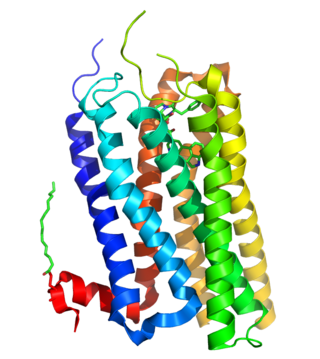Related Research Articles

Pergolide, sold under the brand name Permax and Prascend (veterinary) among others, is an ergoline-based dopamine receptor agonist used in some countries for the treatment of Parkinson's disease. Parkinson's disease is associated with reduced dopamine activity in the substantia nigra of the brain. Pergolide acts on many of the same receptors as dopamine to increase receptor activity.

Methylergometrine, also known as methylergonovine and sold under the brand name Methergine, is a medication of the ergoline and lysergamide groups which is used as an oxytocic in obstetrics and in the treatment of migraine. It reportedly produces psychedelic effects similar to those of lysergic acid diethylamide (LSD) at high doses.

Methysergide, sold under the brand names Deseril and Sansert, is a monoaminergic medication of the ergoline and lysergamide groups which is used in the prophylaxis and treatment of migraine and cluster headaches. It has been withdrawn from the market in the United States and Canada due to adverse effects. It is taken by mouth.

The 5-HT2A receptor is a subtype of the 5-HT2 receptor that belongs to the serotonin receptor family and is a G protein-coupled receptor (GPCR). The 5-HT2A receptor is a cell surface receptor, but has several intracellular locations.

A serotonin receptor agonist is an agonist of one or more serotonin receptors. They activate serotonin receptors in a manner similar to that of serotonin, a neurotransmitter and hormone and the endogenous ligand of the serotonin receptors.

meta-Chlorophenylpiperazine (mCPP) is a psychoactive drug of the phenylpiperazine class. It was initially developed in the late-1970s and used in scientific research before being sold as a designer drug in the mid-2000s. It has been detected in pills touted as legal alternatives to illicit stimulants in New Zealand and pills sold as "ecstasy" in Europe and the United States.

5-Hydroxytryptamine receptor 2B (5-HT2B) also known as serotonin receptor 2B is a protein that in humans is encoded by the HTR2B gene. 5-HT2B is a member of the 5-HT2 receptor family that binds the neurotransmitter serotonin (5-hydroxytryptamine, 5-HT). Like all 5-HT2 receptors, the 5-HT2B receptor is Gq/G11-protein coupled, leading to downstream activation of phospholipase C.
An H3 receptor antagonist is a type of antihistaminic drug used to block the action of histamine at H3 receptors.

Lorcaserin, marketed under the brand name Belviq, was a weight-loss drug developed by Arena Pharmaceuticals. It reduces appetite by activating a type of serotonin receptor known as the 5-HT2C receptor in a region of the brain called the hypothalamus, which is known to control appetite. It was approved in 2012, and in 2020, it was removed from the market in the United States due to an increased risk of cancer detected in users of Belviq.

Ro60-0175 is a drug developed by Hoffmann–La Roche, which has applications in scientific research. It acts as a potent and selective agonist for both the 5-HT2B and 5-HT2C serotonin receptor subtypes, with good selectivity over the closely related 5-HT2A subtype, and little or no affinity at other receptors.

PNU-22394 is a drug which acts as an agonist at serotonin 5-HT2 receptors, with strongest binding affinity for 5-HT2A and 5-HT2C and slightly weaker at 5-HT2B, although it is only a full agonist at 5-HT2C, but partial agonist at 5-HT2A and 5-HT2B. It has anorectic effects in both animal studies and human trials, along with "Pro-Cognitive Properties", although it has never been developed for medical use.

25B-NBOMe is a derivative of the phenethylamine psychedelic 2C-B, discovered in 2004 by Ralf Heim at the Free University of Berlin. It acts as a potent full agonist for the 5HT2A receptor. Anecdotal reports from users suggest 25B-NBOMe to be an active hallucinogen at a dose of as little as 250–500 μg, making it a similar potency to other phenethylamine derived hallucinogens such as Bromo-DragonFLY. Duration of effects lasts about 12–16 hours, although the parent compound is rapidly cleared from the blood when used in the radiolabeled form in tracer doses. Recently, Custodio et al. (2019) evaluated the potential involvement of dysregulated dopaminergic system, neuroadaptation, and brain wave changes which may contribute to the rewarding and reinforcing properties of 25B-NBOMe in rodents.

Serotonin antagonist and reuptake inhibitors (SARIs) are a class of drugs used mainly as antidepressants, but also as anxiolytics and hypnotics. They act by antagonizing serotonin receptors such as 5-HT2A and inhibiting the reuptake of serotonin, norepinephrine, and/or dopamine. Additionally, most also antagonize α1-adrenergic receptors. The majority of the currently marketed SARIs belong to the phenylpiperazine class of compounds.

Vabicaserin was a novel antipsychotic and anorectic under development by Wyeth. As of 2010 it is no longer in clinical trials for the treatment of psychosis. It was also under investigation as an antidepressant but this indication appears to have been dropped as well.
5-HT2C receptor agonists are a class of drugs that activate 5-HT2C receptors. They have been investigated for the treatment of a number of conditions including obesity, psychiatric disorders, sexual dysfunction and urinary incontinence.

25CN-NBOH is a compound indirectly derived from the phenethylamine series of hallucinogens, which was discovered in 2014 at the University of Copenhagen. This compound is notable as one of the most selective agonist ligands for the 5-HT2A receptor yet discovered, with a pKi of 8.88 at the human 5-HT2A receptor and with 100x selectivity for 5-HT2A over 5-HT2C, and 46x selectivity for 5-HT2A over 5-HT2B. A tritiated version of 25CN-NBOH has also been accessed and used for more detailed investigations of the binding to 5-HT2 receptors and autoradiography.

25E-NBOMe is a derivative of the phenethylamine 2C-E. It acts in a similar manner to related compounds such as 25I-NBOMe, which are potent agonists at the 5-HT2A receptor. 25E-NBOMe has been sold as a drug and produces similar effects in humans to related compounds such as 25I-NBOMe and 25C-NBOMe.

25H-NBOMe (NBOMe-2C-H) is a derivative of the phenethylamine hallucinogen 2C-H, which acts as a highly potent full agonist for the human 5-HT2A receptor.

25iP-NBOMe is a derivative of the phenethylamine hallucinogen 2C-iP, which acts as a highly potent agonist for the human 5-HT2A receptor.

The 25-NB (25x-NBx) series, sometimes alternatively referred to as the NBOMe compounds, is a family of serotonergic psychedelics. They are substituted phenethylamines and were derived from the 2C family. They act as selective agonists of the serotonin 5-HT2A receptor. The 25-NB family is unique relative to other classes of psychedelics in that they are, generally speaking, extremely potent and relatively selective for the 5-HT2A receptor. Use of NBOMe series drugs has caused many deaths and hospitalisations since the drugs popularisation in the 2010s. This is primarily due to their high potency, unpredictable pharmacokinetics, and sellers passing off the compounds in the series as LSD.
References
- ↑ Klabunde, T.; Evers, A. (2005). "GPCR antitarget modeling: pharmacophore models for biogenic amine binding GPCRs to avoid GPCR-mediated side effects". ChemBioChem. 6 (5): 876–889. doi:10.1002/cbic.200400369. PMID 15791686. S2CID 33198528.
- ↑ Price, D.; Blagg, J.; Jones, L.; Greene, N.; Wager, T. (2009). "Physicochemical drug properties associated with in vivo toxicological outcomes: a review". Expert Opinion on Drug Metabolism & Toxicology. 5 (8): 921–931. doi:10.1517/17425250903042318. PMID 19519283. S2CID 34208589.
- ↑ De Ponti, F.; Poluzzi, E.; Cavalli, A.; Recanatini, M.; Montanaro, N. (2002). "Safety of non-antiarrhythmic drugs that prolong the QT interval or induce torsade de pointes: an overview". Drug Safety. 25 (4): 263–286. doi:10.2165/00002018-200225040-00004. PMID 11994029. S2CID 37288519.
- ↑ Recanatini, M.; Poluzzi, E.; Masetti, M.; Cavalli, A.; De Ponti, F. (2005). "QT prolongation through hERG K(+) channel blockade: current knowledge and strategies for the early prediction during drug development". Medicinal Research Reviews. 25 (2): 133–166. doi: 10.1002/med.20019 . PMID 15389727. S2CID 34637861.
- ↑ Raschi, E.; Vasina, V.; Poluzzi, E.; De Ponti, F. (2008). "The hERG K+ channel: target and antitarget strategies in drug development". Pharmacological Research. 57 (3): 181–195. doi:10.1016/j.phrs.2008.01.009. PMID 18329284.
- ↑ Raschi, E.; Ceccarini, L.; De Ponti, F.; Recanatini, M. (2009). "hERG-related drug toxicity and models for predicting hERG liability and QT prolongation". Expert Opinion on Drug Metabolism & Toxicology. 5 (9): 1005–1021. doi:10.1517/17425250903055070. PMID 19572824. S2CID 207490564.
- ↑ Huang, X.; Setola, V.; Yadav, P.; Allen, J.; Rogan, S.; Hanson, B.; Revankar, C.; Robers, M.; Doucette, C.; Roth, B. L. (2009). "Parallel Functional Activity Profiling Reveals Valvulopathogens Are Potent 5-Hydroxytryptamine2B Receptor Agonists: Implications for Drug Safety Assessment". Molecular Pharmacology. 76 (4): 710–722. doi:10.1124/mol.109.058057. PMC 2769050 . PMID 19570945.
- ↑ Bhattacharyya, S.; Schapira, A. H.; Mikhailidis, D. P.; Davar, J. (2009). "Drug-induced fibrotic valvular heart disease". The Lancet. 374 (9689): 577–85. doi:10.1016/S0140-6736(09)60252-X. PMID 19683643. S2CID 205953943.
- 1 2 Nichols DE (2016). "Psychedelics". Pharmacol. Rev. 68 (2): 264–355. doi:10.1124/pr.115.011478. PMC 4813425 . PMID 26841800.
- ↑ Treisman GJ, Soudry O (2016). "Neuropsychiatric Effects of HIV Antiviral Medications". Drug Saf. 39 (10): 945–57. doi:10.1007/s40264-016-0440-y. PMID 27534750. S2CID 6809436.
- ↑ Gatch MB, Kozlenkov A, Huang RQ, Yang W, Nguyen JD, González-Maeso J, Rice KC, France CP, Dillon GH, Forster MJ, Schetz JA (2013). "The HIV antiretroviral drug efavirenz has LSD-like properties". Neuropsychopharmacology. 38 (12): 2373–84. doi:10.1038/npp.2013.135. PMC 3799056 . PMID 23702798.
- ↑ "Schedules of Controlled Substances: Placement of Lorcaserin into Schedule IV". 2013-05-08.
- ↑ Moellering, Raymond E.; Cravatt, Benjamin F. (January 2012). "How Chemoproteomics Can Enable Drug Discovery and Development". Chemistry & Biology. 19 (1): 11–22. doi:10.1016/j.chembiol.2012.01.001. ISSN 1074-5521. PMC 3312051 .